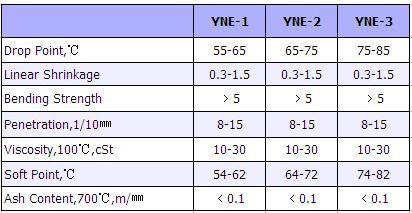Hot sale reasonable price Precision Casting Wax to Greece Factories
Short Description:
Product Detail
Product Tags
Hot sale reasonable price Precision Casting Wax to Greece Factories Detail:
Precision Casting Wax mainly is used for precision mechanical process with zero allowance or very limited allowance. We can not adopt general casting technique, but can only adopt zero allowance casting or precision casting. Because of the product’s structure is very delicate and complex especially in bejeweled with golden and silver, such as diamond ring, brooch, earring etc.
The characteristics of precision casting wax are: good coating property, no denaturalization to be heated, good flow ability, good thermal stability, and well surface finish.
Product detail pictures:

"Based on domestic market and expand abroad business" is our enhancement strategy for Hot sale reasonable price Precision Casting Wax to Greece Factories, The product will supply to all over the world, such as: Curacao , Finland , Madrid , Please really feel free to send us your requirements and we'll respond to you asap. We have got a professional engineering group to serve for your just about every detailed needs. Cost-free samples could be sent for you personally to understand much more information. In an effort to meet your requires, please really feel free to make contact with us. You may send us emails and contact us directly. Moreover, we welcome visits to our factory from around the globe for much better recognizing of our organization. nd items. In our trade with merchants of numerous countries, we usually adhere for the principle of equality and mutual benefit. It is actually our hope to market, by joint efforts, each trade and friendship to our mutual advantage. We look forward to getting your inquiries.
Watch the full episode: https://www.thisoldhouse.com/watch/ask-toh-nasa-simulated-panels
Ask This Old House plumbing and heating expert Richard Trethewey helps a homeowner install an indirect water heater onto an existing steam boiler to boost the amount of hot water in the house.
Click here to SUBSCRIBE to the official This Old House YouTube channel: https://www.youtube.com/subscription_center?add_user=thisoldhouse
Time:
5-6 hours
Cost:
$3000
Skill Level:
Difficult
Tools List:
Hose
Water pump
Level
Propane torch
Pipe cutter
Adjustable wrench
Pipe wrench pliers
Shopping List:
1” copper pipe
½” copper pipe
Y-Strainer
Ball valves
Shut off valves
Circulator Pump
Thermostatic mixing valve
Relief valve
Water temperature sensor
Sensor relay
Solder
Shims
Sand cloth
Pipe dope
Steps:
1. Turn off the main power switch on the boiler and the main water supply to the boiler.
2. Hook up a hose and water pump to the boiler’s draw off valve to drain down the water in the boiler. If possible, pump the water into a utility sink or extend the hose outdoors.
3. Find a spot for the new water heater. Use shims and a level to make sure it is sturdy and level.
4. Find a workable place to tap into the boiler to connect the boiler to the indirect water heater via the heat exchanger coil- preferably just below the water line to avoid any potential for sludge near the bottom of the boiler.
5. Dry fit 1” copper pipe connections from boiler to the heat exchanger coil input. Be sure to place a ball valve shut off at the tap point. Place a Y-Strainer after the ball valve to act as a filter and flush point. Use appropriate adapter pipe fittings, pipe dope and plumber’s tape to connect piping. Make sure all connections are level.
6. Before soldering any copper pipes, be sure to use sand cloth and flux on all the connections.
7. Solder the connections with solder and a propane torch.
8. Break the connection to the boiler draw off valve. This input will now serve as the return for the heat exchanger coil and a draw off.
9. Dry fit 1” copper pipe connections from the heat exchanger coil output to the input of the boiler. The pipe run should include a circulator pump, a purge valve, shut off ball valve and a second purge valve in that order.
10. Solder the connections with solder and a propane torch.
11. Break the connection to the main water supply into the boiler using a pipe cutter. Be sure to have a bucket ready to catch any excess water.
12. Dry fit ½” copper pipe connections from the main water supply to the cold water input at the bottom of the indirect water heater. Use appropriate adapter pipe fittings, pipe dope and plumber’s tape to connect piping. The pipe run should include a tee coupling to reconnect the new run to the boiler. Include a shut off valve after the coupling into the boiler. Extend piping off the middle portion of the tee coupling. Pipe should extend to the indirect water heater and include a draw off valve at the cold input. Additional pipe should also be connected to the thermostatic mixing valve.
13. Break the connection from the boiler to the main hot water feed into the home using a pipe cutter.
14. Dry fit the ½” copper pipe connections from the output on top of the indirect water heater. The pipe run should feed to a relief valve, the thermostatic mixing valve and connect to the main hot water feed into the home.
15. Solder the connections with solder and a propane torch.
16. Attach a temperature sensor to the indirect water heater.
17. Attach an electronic relay to the boiler.
18. Make the electrical connections from the temperature sensor to the relay on the boiler and the circulator pump.
19. Turn the main power switch on the boiler back on.
20. Turn the water supply valve back on.
21. Use the purge valves to eliminate any excess air in the system. You’ll need a bucket to catch the water.
22. It will take some time for the water heater tank to fill and heat up.
Follow This Old House and Ask This Old House:
Facebook: https://www.facebook.com/ThisOldHouse
Twitter: https://twitter.com/thisoldhouse
https://twitter.com/asktoh
Pinterest: https://www.pinterest.com/thisoldhouse/
G+: https://plus.google.com/+thisoldhouse/posts
Instagram: https://instagram.com/thisoldhouse
Tumblr: https://thisoldhouse.tumblr.com/







